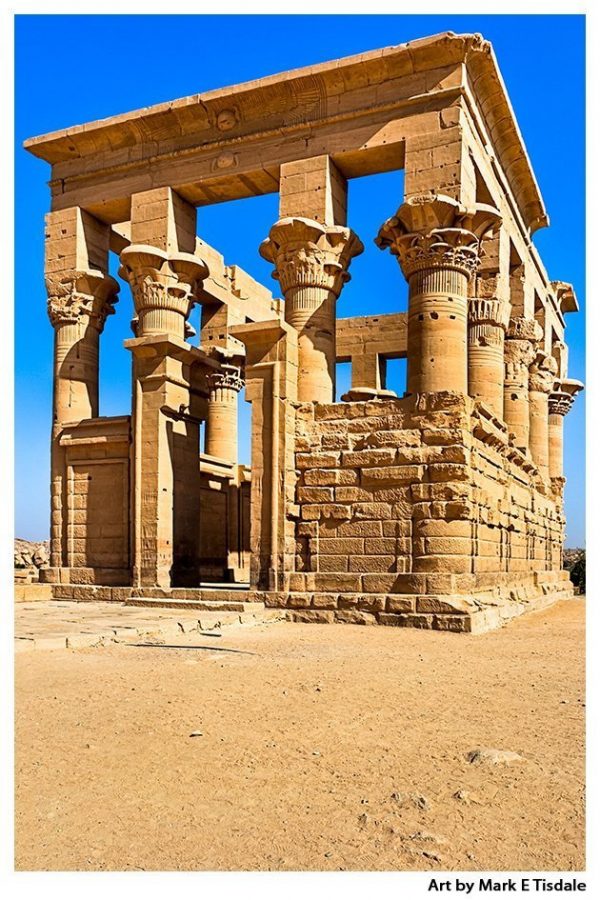Trajan’s Kiosk on Philae – Roman Egypt Art Prints
Prices From:
$24.00
Made to Order – Whether you’re purchasing wall art, home decor, or stationery, each item is created individually after you place your order, ensuring it’s made just for you.
About This Image
It’s been so long since I visited the Egyptian ruins on the Island of “Philae” that I’m honestly not sure if I knew then that they had connections to ancient Rome or not? I put Philae in quotes because the real sacred island of Philae rests beneath the waters of Lake Aswan today. When the first dam on the Nile was built, the island was submerged periodically. When the high dam was built in the 1960s, Philae was completely submerged, but not before the temples on the island, like Trajan’s Kisok seen here, were taken down and re-assembled on the island of Agilkia
Whether I knew about the connection with Rome or not, an at least subconscious connection would explain why the architecture of this particular temple on Modern Philae attracted my attention. There was just something about those columns, a mix of Roman and Egyptian architecture that spoke to me. This temple is known as Trajan’s Kiosk. For good or bad, the Romans were ultimately a consummate multicultural society. Traditionally they didn’t eradicate other cultures but attempted to subsume them. When they conquered a people, there was an attempt to meld their religions and customs. In that vein, Trajan’s Kiosk has a relief inside showing Emperor Trajan making an offering to the Egyptian gods Osiris, Isis and Horus.
Perhaps had I visited Trajan’s Kiosk on the original Philae, I would have a different feeling, but to me the reconstructed Philae felt quite genuine. I was thrilled to see the ruins of Abu Simbel, but there was ultimately a sensation that they weren’t where they belonged. I believe I would have felt that way even if I hadn’t heard the story of the Nubian monuments being moved in the 1960’s. But standing before the temples on Philae, it felt perfectly natural. I guess it is, after all, easier to move a building than a whole mountain!
Have you visited the island of Philae and seen Trajan’s Kiosk as well? Or perhaps you’re a student of history who simply loves the cross-pollination of cultures seen in this ancient architecture? I hope you might take a second to share what attracts you to this particular Egypt print?
Note: Philae is a UNESCO designated World Heritage Site
Art Print – Product Information
Elevate your home or office decor with a high-quality, custom-produced art print. Each print is individually made to order on premium, acid-free paper and printed with archival inks, ensuring vibrant, long-lasting color that will remain beautiful for years.
Every art print includes a 1″ white border, which is added to the overall size. This extra border on each side makes it easy to mat and frame your artwork for a polished, professional look. Optional matting and framing are also available for added convenience.
Prints without framing will be carefully rolled and packaged in a durable cardboard tube or triangular mailing box to ensure safe delivery. Framed prints will be shipped in a flat, secure box.
Where To Buy
My artwork is available as prints through a selection of trusted partner platforms. In some cases, a piece may only be available on one site, which serves as my primary platform. For more details about the features and options each partner offers, click here to learn more (link opens in a new tab).
If you’re interested in purchasing this piece through a specific partner and don’t see it listed, feel free to message me to check on availability. I’ll be happy to assist.

How Can I Help You?
Just so you know, you’re not simply browsing through the offerings of yet another faceless corporate monolith, you’re connecting with me, the artist behind every print offered for purchase here.
I’m here to answer any questions you may have, help you find the perfect print, or discuss any custom touches that might make your purchase even more personal.
I believe in treating my customers the way I’d want to be treated, with authentic concern and attention. Whether you have product questions before your purchase or seeking another subject, I’m here to help you however I can.
Art has been my passion and my livelihood for almost 20 years. I’m grateful for every person who chooses to bring my work into their space or gives it as a truly personal gift. Please do let me know how I can help make your experience a great one!




Reviews
There are no reviews yet.